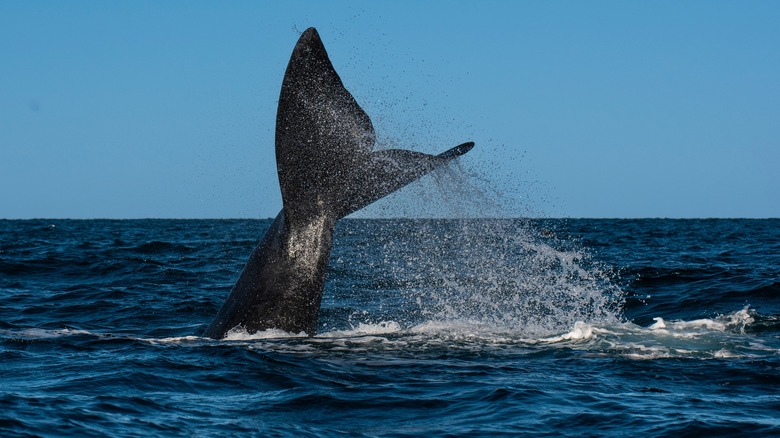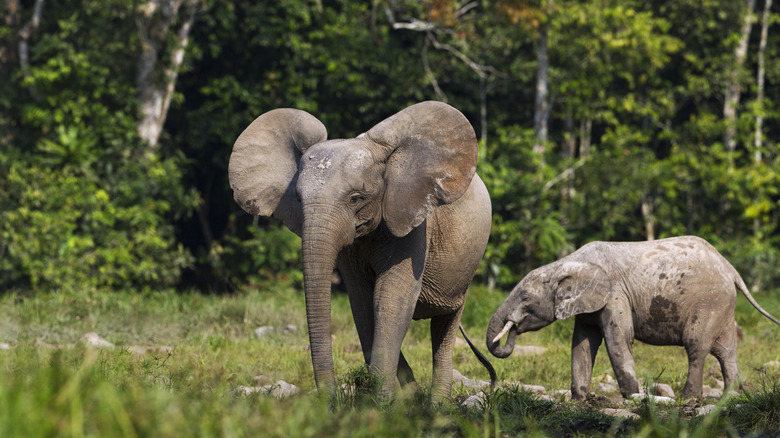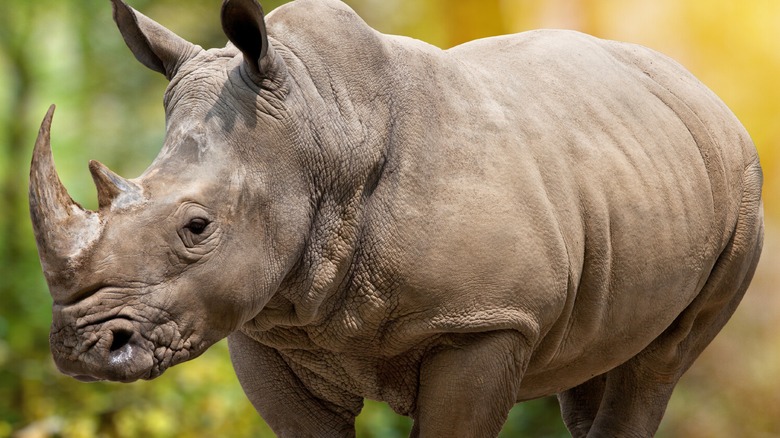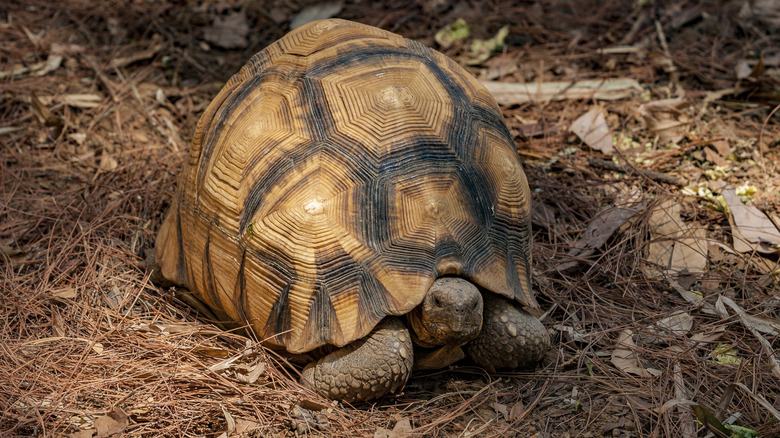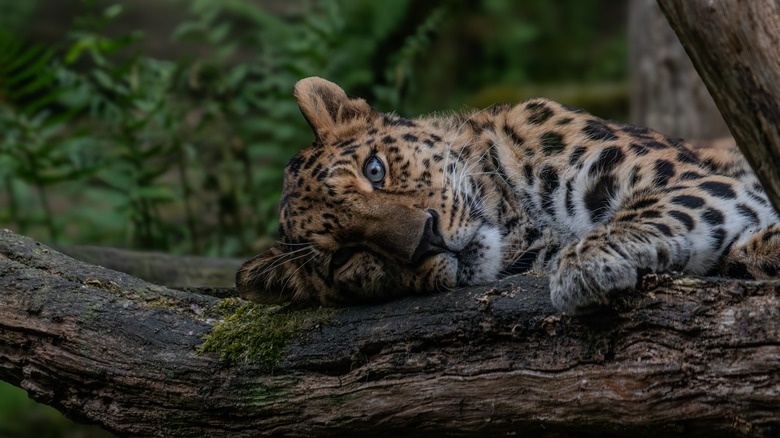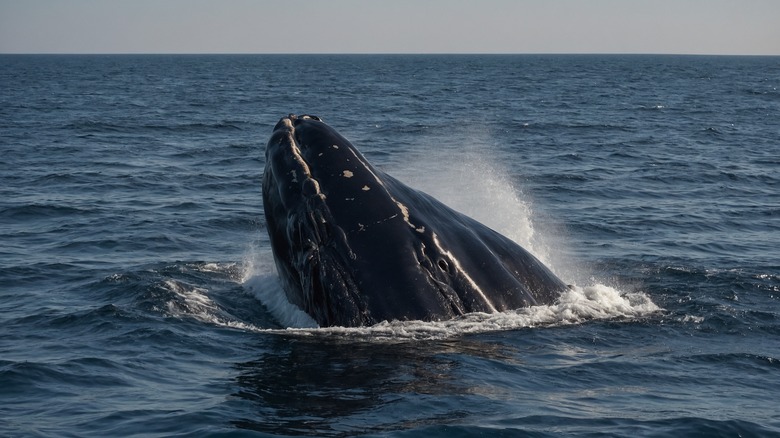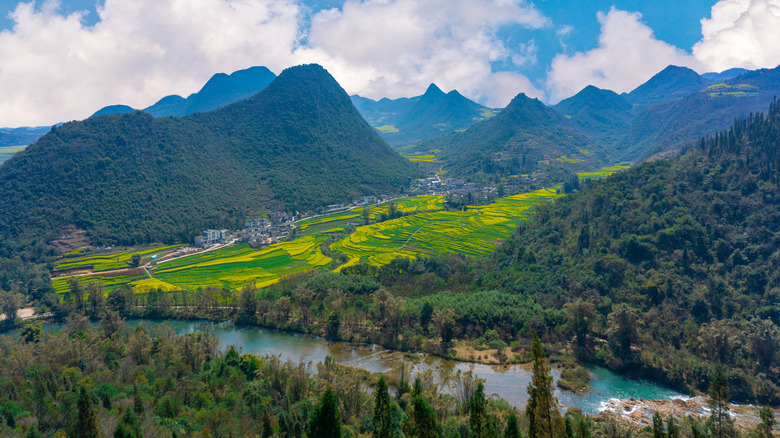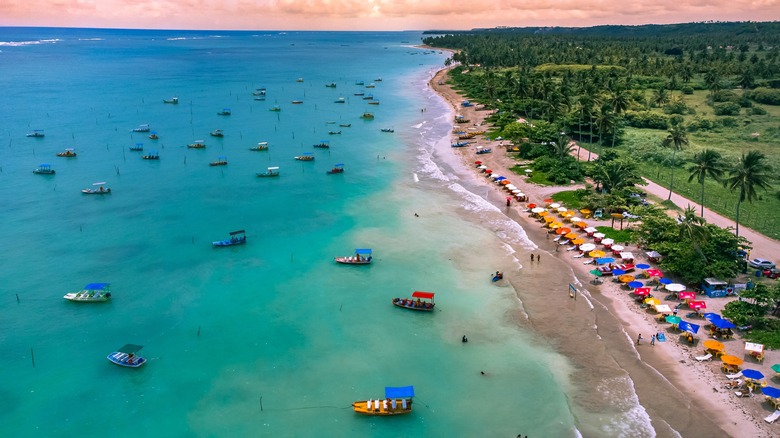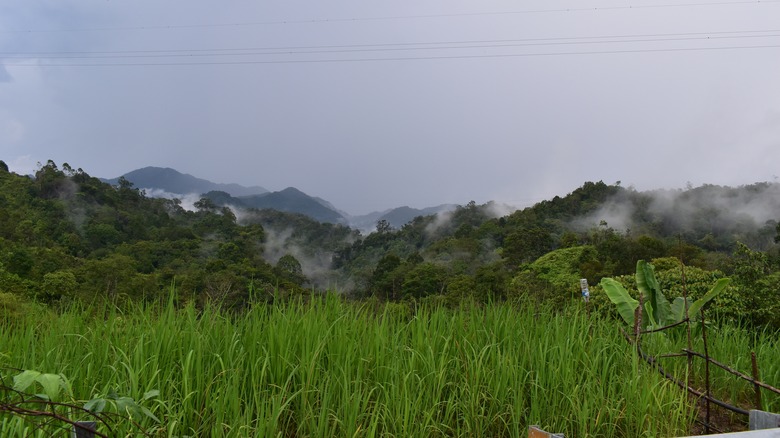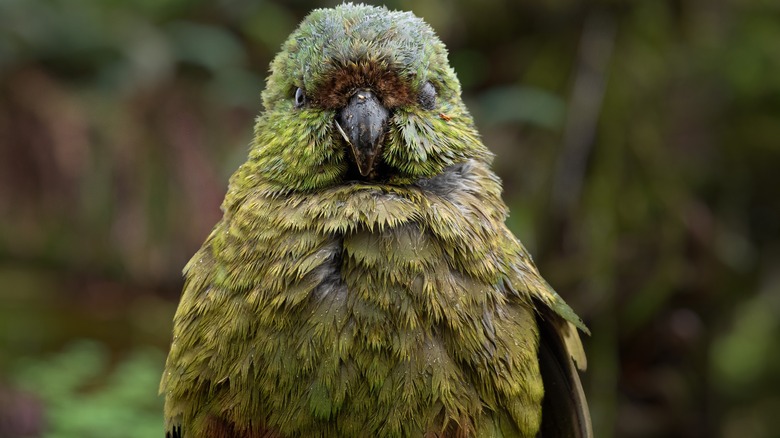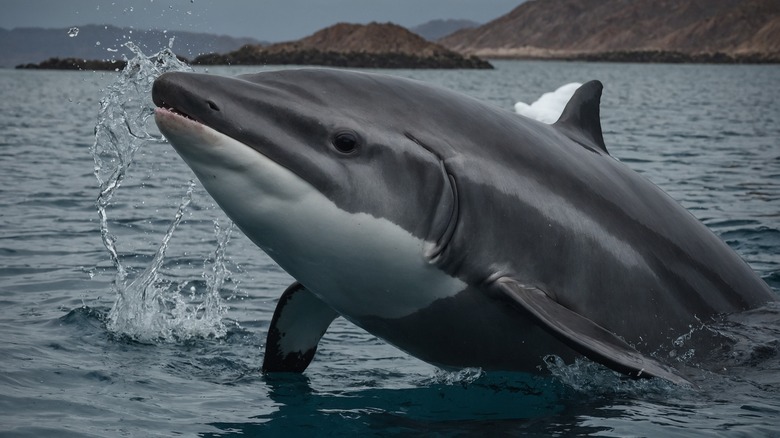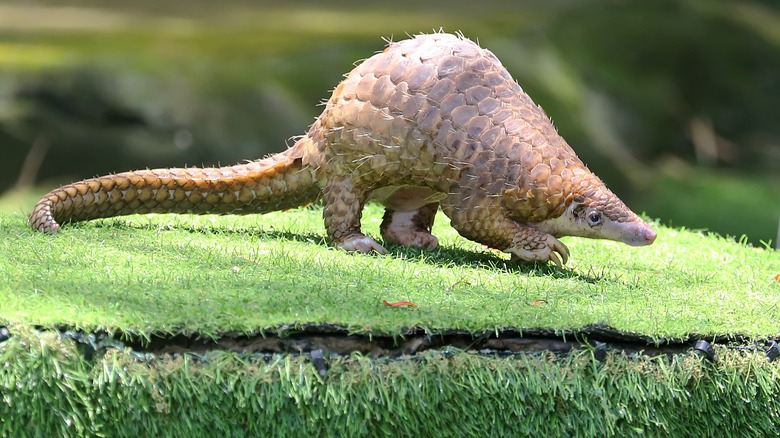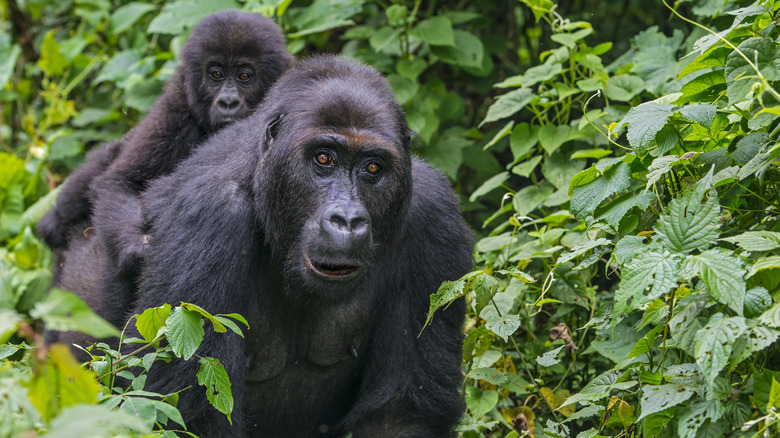12 Animal Species On The Brink Of Extinction
As climate change poses an increasingly dominant threat to certain life forms on Earth, environmentally concerned individuals, conservationists, and organizations are also raising awareness about the species that are most at risk and trying to make efforts to prevent extinction. The International Union for Conservation of Nature and Natural Resources (IUCN), for example, has a "red list" of more 166,000 species, many of which are animals. Of these, over 46,300 species are threatened with extinction.
Each species also has a category from the IUCN related to their estimated population that ranges from least concern to extinct. The species of most concern fall into three categories: vulnerable, endangered, or critically endangered. Having a critically endangered status means there's a high likelihood that a particular species is facing continuous threats to their population and viability, and that steps must be taken to prevent animal extinction. In some cases, there are only a handful members of a certain species surviving. Among the most critically endangered animals on Earth include certain mammals, reptiles, and birds.
African forest elephant (Loxodonta cyclotis)
While all elephant species are considered endangered, the African forest elephant's status is the most critical. These magnificent creatures are the largest mammals on Earth, with the average male African forest elephant reaching more than 9 feet tall. They also weigh around 12,000 pounds. Unfortunately, their magnificence and grace have also garnered negative attraction, from poaching and illegal wildlife trading. Like other elephants, African forest species are also constantly conflicting with humans in the wild due to loss of food, as well as the loss of the natural habitat of elephants associated with land development. It's estimated that the African forest elephant population decreased by an astonishing 86% in just over 30 years.
There are several actions taking place to help protect all elephant populations in Africa, including the African forest elephant. First, conservationists are closely monitoring herds and their habitats, while also reporting any suspected ivory poaching activities. Several organizations are also working with local residents to help reduce deadly encounters between humans and elephants so that both may share the land peacefully with one another. The potential extinction of the African forest elephant would also significantly disrupt the ecosystem, as they help disperse seeds for plant growth, and also act as natural landscapers of overgrown woodlands as they walk through them. Until their population turns around, African forest elephants remain on the critically endangered list since they were first classified as such in 2021.
Javan rhinos (Rhinoceros sondaicus)
Many of the world's rhinos are threatened, but the Javan rhino is undoubtedly in the most critical category. In fact, it's estimated there are less than 70 members of these species left, and they all live in Indonesia's Ujung Kulon National Park. These rhinos are indigenous to tropical portions of Asia, and they once roamed freely along a wide area that included southeastern portions of the continent and upwards towards northeastern India. It's known for its dark gray, armor-like body and large single horn that can grow up to 10 inches long. This species of rhino can also grow up to nearly 6 feet tall and weigh as much as 5,000 pounds.
While there were around 76 Javan rhinos within the last decade, poaching problems on Ujung Kulon National Park grounds have decreased the population by another 26 since 2018. Such heartbreaking events highlight the issue of trying to support and protect Javan rhinos while still providing them with a wild habitat. Aside from extra security measures, the Rhino Recovery Fund and other organizations are also working to educate the public on conservation efforts, too. While all remaining Javan rhinos live in Ujung Kulon National Park, poaching prevention is the current key to preventing total extinction of this critically endangered species.
Ploughshare tortoise (Astrochelys yniphora)
Also known as the angonoka tortoise, the ploughshare tortoise is a large reptile that is native to Madagascar. It's also considered the rarest type of tortoise on Earth. Like many other reptiles, the ploughshare tortoise population has struggled with habitat losses due to human activities. However, it's also significantly threatened by poachers and illegal pet traders. Both groups have targeted these tortoises for their identifiable traits, including their beautiful golden, dome-shaped shells. Sadly, this critically endangered species is considered "functionally extinct," meaning that only a few are now thought to live in the wild.
Due to their threats and significantly low population, several groups and organizations are working to help protect the few remaining ploughshare tortoises and possibly help increase their population. First, the Turtle Survival Alliance has two groups of ploughshare tortoises in Madagascar, with one consisting of confiscated animals from illegal trade. The other group consists of younger tortoises that may have a potential to reproduce. Efforts are also being made to help educate the public about the ploughshare tortoise, including ways to surrender tortoises that may have erroneously been taken in as pets. While the future of the ploughshare tortoise remains critical, all of these solutions may just help keep this fascinating species from extinction.
Amur leopard (Panthera pardus orientalis)
Known for their remarkable tree-climbing skills, leopards are arguably one of the most popular cats on Earth. In the wild, several species of leopards were once commonplace in Africa, China, and India. Like other types of large cats though, leopards are increasingly in danger from habitat losses from climate change and deforestation, as well as hunting and illegal wildlife trading. The most vulnerable of all leopards are the amur leopard. Like other types of leopards, these large cats have beautiful coats with black spots. The amur leopard has an exceptionally fluffy tail compared with other species, and they may even use them like coats to protect themselves during the harsh winter months. It's estimated that about 100 of these critically endangered species remain, and they primarily live in the forested mountains of China and Russia. They also get their name from the Amur River, which runs between these two countries.
The amur leopard is considered the rarest and most critically endangered of all leopard species, and human activities are largely to blame for their decline. However, there may be a glimmer of hope for these leopards. It's estimated that recent conservation efforts have helped increase the population to more than 120 adult amur leopards, which is more than the 30 that were thought exist in the 1970s. Furthermore, researchers believe there are more female amur leopards than there are males, which may increase the likelihood of reproduction. If more amur leopard cubs survive, this species may be able to stave off extinction.
North Atlantic right whale (Eubalaena glacialis)
Whales are among some of the world's most majestic, yet vulnerable, creatures. Efforts have been made in recent decades to help save whale species, with some, such as the humpback whale, experiencing renewed population growth. However, the situation has not been favorable for the North Atlantic right whale. These whales are identifiable with their V-shaped blow spouts, stocky bodies, and lack of dorsal fins. Like other right whales, the North Atlantic right whale suffered population losses due to the commercial whaling industry, and they were almost extinct by the 1890s. It is now considered one of the most critically endangered whales in the world. Modern-day threats include climate change, vessel strikes, and accidental entanglement in fishing nets. Additionally, ocean noise from ships and other human-generated activities can disrupt vital communications between these whales.
Today, it is estimated that less than 350 North Atlantic right whales remain in the wild. What's more, scientists have noted an increased mortality rate in these whales since 2017. North Atlantic right whales can potentially live up to 70 years, barring any dangerous encounters with human activities. In fact, the average life expectancy currently stands at 65 years for males, and 45 years for females. Conservationists and federal agencies are working to help increase North Atlantic right whale population numbers while also extending their lifespans. This is primarily being done in the way of education coupled with laws to help reduce vessel speeds, pollution, and noise.
Yunnan box turtle (Cuora yunnanensis)
Like the ploughshare tortoise, there are several species of box turtles that are considered either endangered or critically endangered. While several box turtle species are endangered, the Yunnan box turtle is in the most critical category. In fact, since their last assessment by the IUCN, it's thought that up to 50 remained in the wild, and the overall population trend is continuing to track downward. There's also some debate over whether the box turtle might already be extinct, as one published study in the Proceedings of the Royal Society B Biological Sciences indicated in 2004. The IUCN last updated their Yunnan box turtle data in 2009.
As their name suggests, this box turtle species is native to Yunnan, a southwestern inland province of China. While each Yunnan box turtle has an average lifespan of 20 years, the species has suffered irreversible population losses related to pollution, poaching, and illegal pet trading. The IUCN has identified one conservation area in Yunnan for these turtles, but little is known about any educational programs to help prevent them from going extinct. Fieldwork is needed to determine how many Yunnan box turtles might still be alive.
Daggernose shark (Isogomphodon oxyrhynchus)
Known for its exceptionally long snout, the daggernose shark is one of the most critically endangered sharks in the world. At 5 feet long, this shark on the endangered species list prefers to live in shallow waters, particularly in those in estuaries and along the coasts of northeastern South America as well as in the Caribbean Sea. The daggernose shark has been most recently observed near northern Brazil, Venezeula, Trinidad, and other countries in the region, though its habitat has significantly decreased. In fact, daggernose shark sightings are considered rare, with unregulated fishing operations considered their largest threat.
Today, the daggernose shark is considered by scientists as being close to extinction. Not only does the shark continue to be a victim of fishing, including accidental encounters, but the juveniles are struggling to survive on the whole. This means fewer daggernose sharks of reproductive age to help the species survive. Overall, male daggernose sharks may only live up to 12 years, while females may survive for 20. While awareness of the shark and its status is critical, the IUCN has not identified any formal recovery plans being implemented to reverse the daggernose shark population decline.
Tapanuli orangutan (Pongo tapanuliensis)
All orangutans are considered endangered species, with their decreased populations primarily attributed to habitat losses. Of the three different types, however, the Tapanuli species is at greatest risk of extinction. First officially announced in 2017, the Tapanuli orangutan was first discovered in the late 1990s in the region of Tapanuli in Sumatra, Indonesia. Sadly, it's estimated there are only about 800 Tapanuli orangutans left in the wild. Aside from habitat loss from human activities, these rare apes are also subjected to hunting.
Since their discovery, conservationists have made an effort to study the Tapanuli orangutan as well as try to come up with solutions to help save this critically endangered species. To date, there are now less than 250,000 acres in the Batang Toru forests in which the Tapanuli orangutan can be found. There are also local conservation teams on the ground that help patrol the area and monitor it for signs of illegal logging, hunting, and other activities that might harm these orangutans. Another concern, however, is the construction of the Batang Toru dam, which could pose devastating consequences for the Tapanuli orangutan and other species who call the mountainous forests home.
Kakapo (Strigops habroptilus)
Indigenous to New Zealand, the kakapo are considered one of the world's most critically endangered birds. Aside from its endangered status, the kakapo is also known for their unique characteristics. This bird is technically classified as a type of large nocturnal parrot, although its facial features are reminiscent of owls. While the species doesn't fly, it can climb quite well. Researchers believe the kakapo may have the longest lifespan of all birds on Earth, with an average expectancy of 90 years. However, it's also estimated there are only 244 kakapo remaining.
Like many of the world's endangered birds, kakapo are victims of human activities. Before the 1800s, it's thought the species was ubiquitous throughout all areas of New Zealand. However, habitat losses, hunting, and invasive predators affected the population so poorly that the earliest known conservation efforts for this bird date back to 1894. Kakapo were almost completely extinct by the mid-20th century. While the species has been saved thanks to local conservationists, the IUCN still regards the kakapo as critically endangered due to low numbers and ongoing threats in the wild.
Vaquita (Phocoena sinus)
Vaquitas are cetaceans that belong to the same family as porpoises and all different kinds of dolphins. It's thought they are also among the smallest and shyest in this family. Unfortunately, the inability to spot vaquitas in the wild goes beyond their shy demeanor. They are considered the world's most endangered cetacean, with only about 10 left in the wild. The vaquita population has rapidly declined in recent years due to the fishing industry, where the porpoises often become entangled in nets that are meant for other species. It's thought the remaining vaquitas live along the Gulf of California, with average lifespans of 20 years. They are also nicknamed "Gulf of California harbor porpoises."
It's difficult to determine exactly how many vaquitas remain in the wild. So far, lawmakers have made efforts to protect these critically endangered cetaceans through fishing laws. One example is the outlawing of totoaba, a large fish that was cited for the reason why the vaquita population dropped so dramatically during the early 21st century. Fishing for totoaba can inadvertently lead to vaquita entanglement in nets, a practice that is now illegal.
Pangolin (Pholidota)
Considered among the world's most trafficked types of animals, the pangolin continues to be under threat from human activities. These fascinating reptile-like, insect-eating species are thought to have existed since prehistoric times. In fact, researchers estimate that pangolins have been on Earth for more than 80 million years. They are considered indigenous to Asia and Africa, where they protect themselves from predators with their sharp, scaly bodies. It's difficult to pinpoint exactly how many pangolins remain in the wild because of their nocturnal nature.
Unfortunately, while pangolins have survived through the ages and can even ward of many wild predators, they are victims of illegal human activities. Not only are they taken as part of the illegal pet trade, but they are also hunted for food and medicine. International laws against these types of practices are in place, but many pangolin specie populations are still decreasing. All species have either a vulnerable or endangered status, with three types of pangolin considered critically endangered: the Chinese pangolin, Philippe pangolin, and Sunda pangolin. Aside from illegal trading and hunting, other human threats to pangolins include land development for housing and transportation.
Eastern lowland gorilla (Gorilla beringei graueri)
The Eastern lowland gorilla is considered the most endangered of all gorilla species. Also called Grauer's gorilla, they are also the world's largest gorilla, weighing as much as 440 pounds and standing up to 5 ½-feet tall. Unlike other types of gorillas, the eastern lowland gorilla has shorter fur and is also identifiable by a narrower face. Overall, the population of this critically endangered species has decreased by an astonishing 50% since the 1990s. This is largely due to the result of human conflict within the rainforests of the Democratic Republic of Congo that these gorillas call home, which has destroyed much of their native habitat. Aside from habitat destruction within the gorilla's ecosystem, the eastern lowland gorilla continues to be threatened by illegal mining and poaching.
Some researchers estimate that there may be fewer than 6,000 eastern lowland gorillas remaining in the wild. However, it's challenging to determine exactly how many of these gorillas there really are in the region because of ongoing wars that have minimized access to fieldworkers. Nevertheless, conservation efforts are still being made to protect this vulnerable gorilla. This is dangerous work that has even involved staff of the Kahuzi-Biega National Park to take land back from rebels who have trespassed onto park grounds and contributed to declining gorilla populations.
